Eight ways addiction is affecting your workplace
February 27, 2019

Addiction is present within every industry, company and community. More than 70 percent of people with addiction are employed either part- or full-time. But because of the nature of this disease, and the shame that comes with it, many suffer in silence.
Though costly, many addiction symptoms aren’t very obvious or visible – especially in the earlier stages of the disease. We’ve outlined eight ways untreated addiction negatively impacts every company, regardless of industry, location or size, according to research.
1. Health care costs
Hospital emergency services, primary care visits and overall healthcare use are increased among those suffering from addiction. The healthcare costs for workers misusing pain medication are three times greater than the average employee, and those workers are twice as likely to have been hospitalized in the past year.
2. Absenteeism
Employees with untreated addiction miss nearly 50 percent more days than their peers, averaging 14.8 days a year of unscheduled leave. Workers who misuse prescription pain medication miss 29 days annually. They’re also three times as likely to be late for work.
Interestingly, employees in recovery have been shown to miss the fewest days of any demographic, including the general workforce not impacted by addiction.
3. Presenteeism
Productivity is severely impacted among employees affected by addiction. As the disease progresses, it’s more likely workers will be distracted or experience physical symptoms that limit their capacity at work. One group that's important to keep in mind is loved ones. The productivity of employees who support someone with addiction – parents, spouses, siblings – can be drastically undermined for extended periods of time. Learn more about the impacts on loved ones with this story.
4. Attracting workers
The ability to find and hire qualified workers is a growing challenge in many industries, especially construction and related trades. The worker shortage is driven by economic growth but exacerbated by the growing opioid crisis, as an increasing number of candidates can’t pass mandatory drug tests. Employers need better tools to offer support to potential employees so they can minimize the impact of the labor shortage on their business.
5. Turnover
Similar to attracting employees, retaining them is vitally important. Addiction can play a significant role in company turnover. This is especially true when it comes to loved ones concerned about a family member who is struggling. They may feel they need to leave their job in order to take care of someone they love.
Time spent recruiting and training new employees is a drain on personnel and resources. Studies have found it costs an average of six to nine month’s salary every time a business replaces a salaried employee. High turnover also has a negative effect on workplace culture.
6. Safety
Rates of workplace accidents, injuries and even fatalities are all increased among work sites where addiction is present. Mistakes due to inattention or poor judgment are also more likely, and can be increasingly dangerous depending on the industry.
7. Risk
Beyond safety, untreated addiction can lead to increased liability for employers. Risk is undoubtedly increased among employees with untreated addiction. Driving a company vehicle or inappropriate behavior at a company event are just a couple of ways that an employee under the influence can put a company at risk.
8. Culture conflict
Even among companies committed to health and wellness, if there isn’t an open dialogue about issues like mental health and addiction, employees may still fear seeking help. The stigma and shame surrounding addiction is incredibly difficult to overcome, especially in the workplace. Even loved ones are often reluctant to share what they’re going through. A supportive culture must include an open commitment to breaking the stigma of addiction.
Despite all the costs and risks surrounding untreated addiction in workplaces, research has shown employees in recovery are assets to employers. Ultimately, it’s in employers’ best interests to help their employees get well and stay well. See the estimated cost per year of addiction to your business here.
The good news is that employers have tools at their disposal to help workers and their family members get well with effective and meaningful support, such as Face It TOGETHER’s @ Work program. FIT @ Work is private, effective and easy to implement.
To learn more about how FIT @ Work can help your employees and their family members – while providing a strong return on investment to your company – please contact us.
